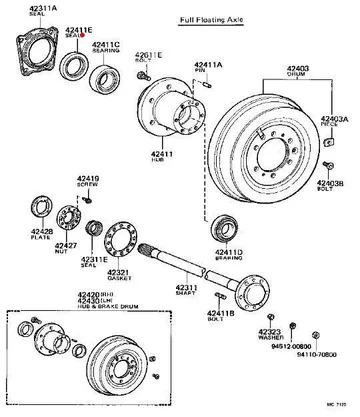Dougal, your fault is lack of actual experience.
since you have never been in the situation where you NEEDED to get home with a broken pinion allow me to state the obvious.
typical FF toyota setup.
grease in the hub bearings
seal in end of axle tube
gear lube in the housing
axle in.
pinion shaft breaks, which means you can not drive forward since the pinion rotation takes the broken off head into the ring gear and locks the rear end solid.
you can back up since the rotation pushes the head back into the pinion hole but who wants to back all the way home.
so, you pull both axle shafts out of the rear diff.
you stuff a rag into the axle housing end where the seal is, this stops the raging flow of gear lube which will contaminate the grease in the hub which will dilute the grear and make for seized bearings (yes it does happen. i have seen it more than once over the 30 years)
so the flow is stopped.
if you have a short drive with no mud, water or dirt then leave as is and drive home.
but
if you have mud, water or dirt to drive through then take duct tape and cover the end of the hub, this will allow the grease in the hub to remain uncontaminated and you can drive from North Dakota to Kitteridge Colorado (and probably much further)
non-typical FF toyota setup.
gear lube in the hub bearings
no seal in end of axle tube
gear lube in the housing
axle in.
now the pinion breaks and the before mentioned situation has developed
you remove the axle shafts which now allows the hub area to have no protection and no way to keep the gear lube (much more liquid than grease) into the hub area.
because it is a rotating mass then you can not use a plastic bag, duct tape or any other means to keep that gear lube from flowing out from around the bearings.
in other words, if you have a FF, whose great advantage over a SF is the ability to run without axle shafts in place, can not perform that function. then why even run a FF.
in the OP original post he is driving an 80, the chances of an 80 hauling a large enough load to be too heavy for a SF but okay for a FF is slim to none. FF redundant. if he doesn't have factory electric lockers or limited slip then the FF is redundant. if he switches to the full gear lube idea then the ability to run without the rear axles is redundant.
as for the benefit of running gear lube over grease, i never said that gear lube wouldn't lubricate the bearings, i said they were not designed for that purpose, the hub were designed for weight carrying and designed for grease. what i did say was that the gear lube won't stay in the bearing area and you will have a seized bearing due to no lubrication.
in the end, try it. but might be best to try it where there are no other individuals on the road.
<the entry point is the seal, Dougal, if you ever did any actual wheeling you would know this>
There are no end of ways to get home with a broken or removed half shaft. If you don't know them, it's not my fault.
And if you find water in your oil, then it pays to find the entry point.








 I had oil all over my rear tyres and spattered on my paint.
I had oil all over my rear tyres and spattered on my paint.